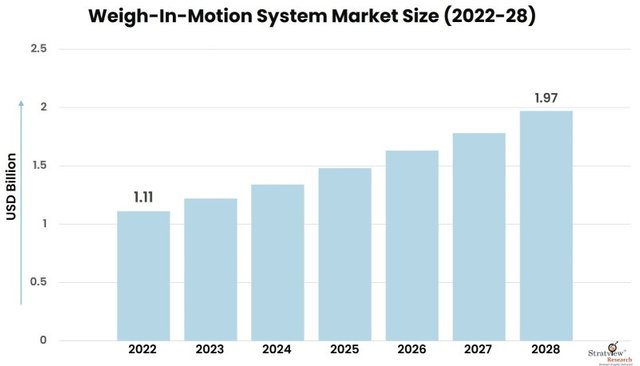The weigh-in-motion systems market is experiencing substantial growth, driven by the increasing demand for real-time, efficient traffic monitoring and management solutions. As industries such as transportation, logistics, and road infrastructure continue to evolve, weigh-in-motion systems are becoming essential for optimizing traffic flow, enhancing road safety, and improving freight management. This article explores the key factors driving the growth and expansion of the global weigh-in-motion systems market.
According to Stratview Research, the weigh-in-motion system market was estimated at USD 1.11 billion in 2022 and is likely to grow at a healthy CAGR of 10% during 2023-2028 to reach USD 1.97 billion in 2028.

1. Increasing Need for Traffic Management and Safety
One of the primary factors fueling the growth of the weigh-in-motion system market is the rising need for better traffic management and road safety. As global road networks experience increased congestion due to growing populations and expanding urban areas, weigh-in-motion systems offer a solution for effectively managing heavy vehicle traffic. These systems monitor vehicle weight, speed, and axle loads in real time, helping authorities identify overweight vehicles and prevent damage to road infrastructure. This data-driven approach also aids in reducing road accidents caused by overloading, contributing to enhanced public safety.
2. Rising Demand in the Freight and Logistics Industry
The logistics and freight sectors are key drivers of the weigh-in-motion system market, as they rely on accurate weight measurements for operational efficiency and regulatory compliance. weigh-in-motion systems help logistics companies streamline their operations by providing real-time data on vehicle loads, reducing the need for manual inspections, and ensuring that vehicles adhere to legal weight limits. This improves supply chain efficiency, minimizes delays, and lowers transportation costs, driving the adoption of weigh-in-motion systems across the freight industry.
3. Technological Advancements
The integration of advanced technologies such as sensors, data analytics, and the Internet of Things (IoT) has transformed the capabilities of weigh-in-motion systems. Modern weigh-in-motion systems are equipped with cutting-edge sensors that capture precise data on vehicle weight and load distribution. These systems can now communicate with centralized data platforms, enabling authorities to monitor and manage road traffic more effectively. Moreover, the adoption of AI and machine learning algorithms further enhances the accuracy and predictive capabilities of weigh-in-motion systems, driving their expansion in smart transportation networks.
4. Government Regulations and Infrastructure Development
Government initiatives focused on improving transportation infrastructure and ensuring road safety are another key factor driving the growth of the weigh-in-motion system market. Many countries are implementing stringent regulations to control vehicle weight and prevent road damage. In response, authorities are investing in weigh-in-motion systems to monitor and enforce compliance. Additionally, infrastructure development projects, especially in emerging markets, are fueling demand for weigh-in-motion systems to support modern, efficient road networks.
Conclusion
The global weigh-in-motion systems market is poised for continued expansion, driven by the growing need for traffic management, advancements in technology, and the demand for efficient freight operations. As governments and industries recognize the value of weigh-in-motion systems in optimizing road safety and infrastructure, the market is expected to see significant growth in the coming years.